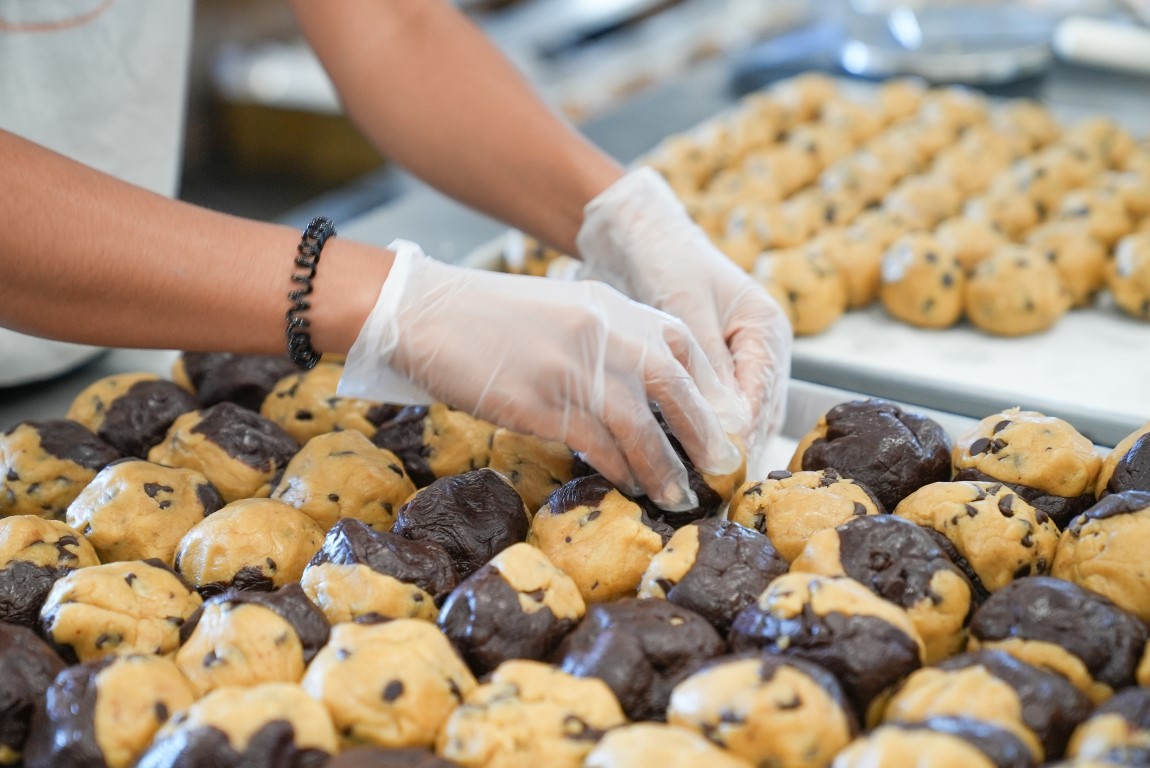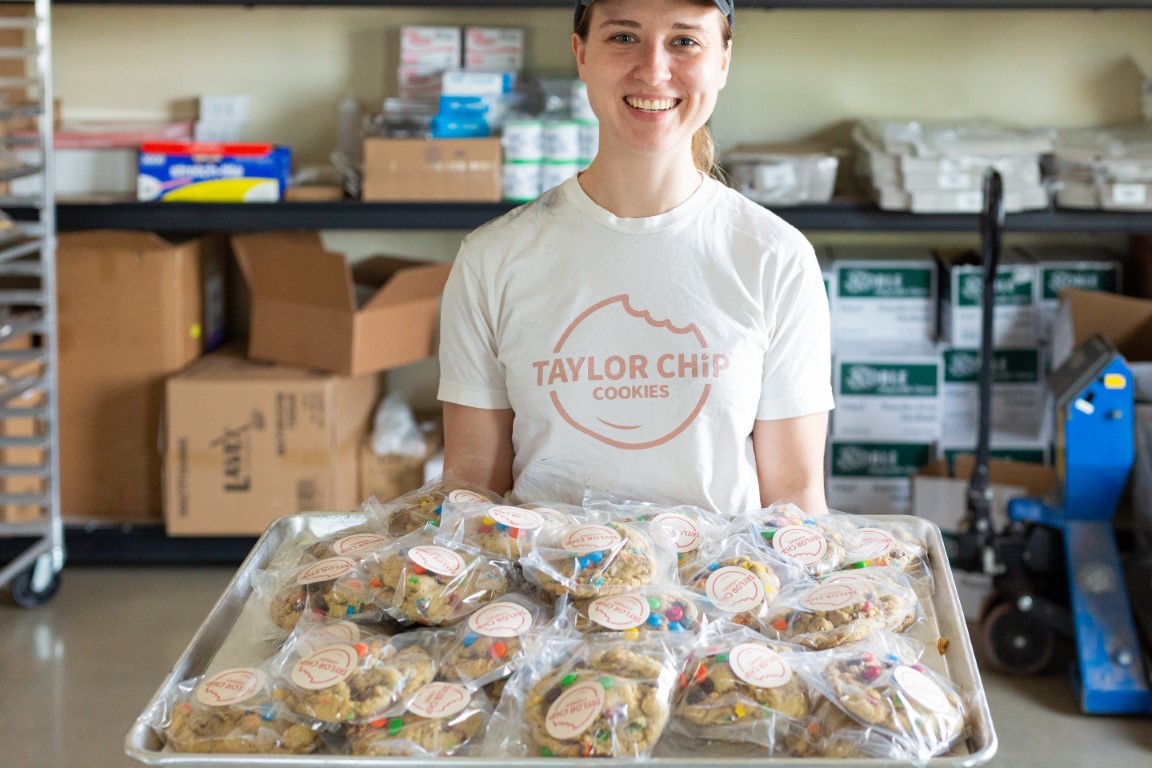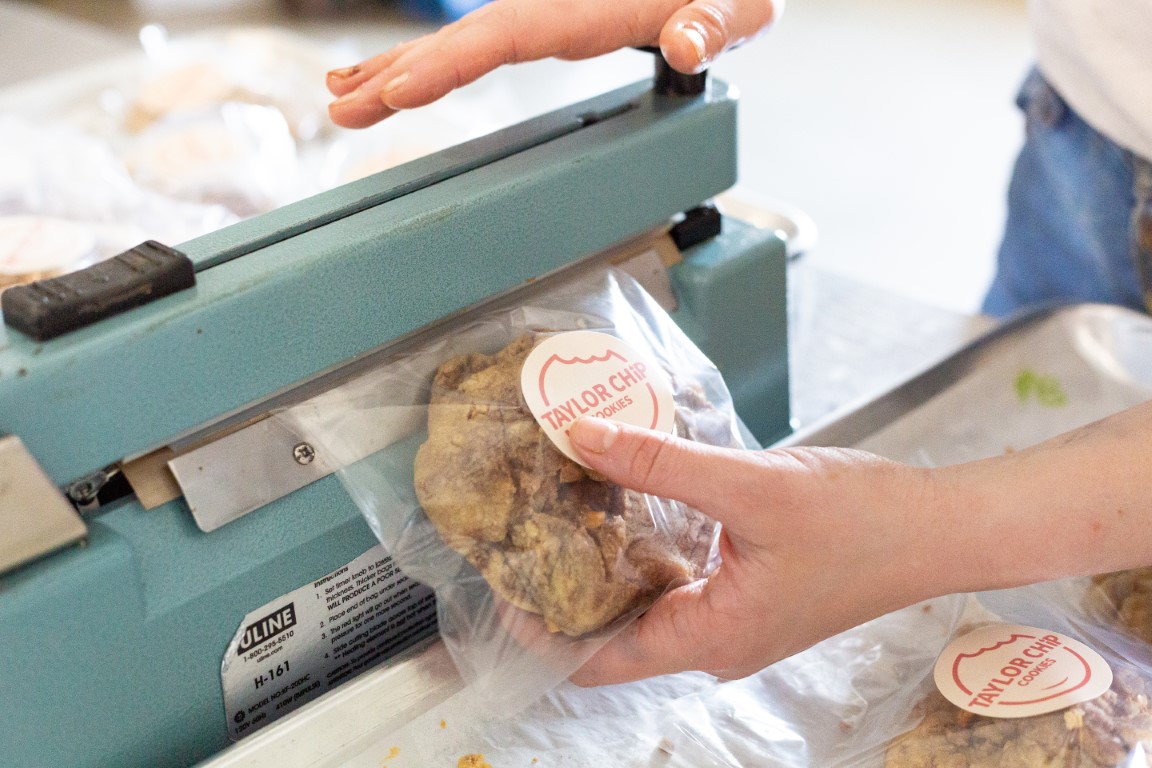When baking chocolate chip cookies, choosing between salted and unsalted butter alters flavor, texture, and baking results. Unsalted butter allows precise control of salt content, maintaining a purer, consistent flavor profile and often resulting in chewier cookies. It provides consistency in baking outcomes by preventing variable chemical reactions caused by salt. In contrast, salted butter introduces extra flavor but requires adjustments in added salt, potentially affecting texture and moisture balance. Most recipes favor unsalted butter for its control and freshness, but preferences vary, allowing experimentation to find the best cookie characteristics and uncover more about your baking choices.
Key Takeaways
- Unsalted butter provides better flavor control and consistency in chocolate chip cookie recipes.
- Salted butter requires recipe adjustments to manage variable salt content and flavor balance.
- Unsalted butter typically results in chewier cookies due to precise salt control.
- Proper butter temperature, whether salted or unsalted, is crucial for optimal cookie texture.
- Experimenting with both butter types helps determine personal flavor and texture preferences.
Understanding Butter Types
When choosing butter for your chocolate chip cookies, understanding the differences between salted and unsalted butter is essential, as each type can greatly impact the final taste and texture of your baked goods. Salted butter contains added salt, which not only alters the overall flavor but also affects the dough's moisture balance and structure. On the other hand, unsalted butter allows you to control the exact amount of salt in your recipe, ensuring consistency and accuracy in your baking.
Key Differences Between Salted and Unsalted Butter
Many bakers find themselves puzzled by the choice between salted and unsalted butter. Understanding this difference in baking is essential. Unsalted butter allows you to control the salt content in your recipe, providing a purer, buttery taste. Salted butter contains varying grams of salt, which can affect the salt level and depth of flavor in your chocolate chip cookies. The choice between these two impacts more than just taste; it influences the chemical reactions during baking, which can alter the texture of your cookies. Opting for unsalted butter might result in chewier chocolate chip cookies, as you control the precise salt content. So, when deciding which butter to use, consider how these differences will affect your final cookie outcome.
Salt Content and Its Impact on Baking
The salt content in butter plays an essential role in baking, influencing both flavor and texture. When making chocolate chip cookies, you must consider the type of butter to use. Salted butter adds a subtle flavor, while unsalted lets you control the salt amount, often a teaspoon salt, in your baking recipe. Combine this with flaky sea salt or kosher salts for a burst of flavor. As you mix wet ingredients like melted butter with purpose flour, the salt's impact becomes evident in your cookies' taste. To achieve perfect chocolate chip cookies, understanding how salt content influences the dough is vital. Depending on your preference, adjusting salt levels allows you to tailor the cookie's final flavor and texture precisely.

Choose Your Own Delightfully Perfect Cookies.
With almost 30 flavors to choose from, you can make your box as unique as you are.
Impact on Cookie Characteristics
When choosing butter for your chocolate chip cookies, it's important to contemplate how it will influence the flavor profile and taste balance, as different butters can impart unique nuances. The texture and structure of your cookies are also affected, with variations in fat content and composition leading to cookies that are either soft and chewy or crisp and crunchy. Additionally, the moisture content of the butter can alter the overall consistency, potentially impacting how your cookies spread and bake.
Flavor Profile and Taste Balance
One essential factor that determines the flavor profile of chocolate chip cookies is the type of butter you choose. When selecting butter for baking, consider whether you want salt crystals to be part of the mix. Salted butter adds a hint of saltiness, potentially eliminating the need for an extra teaspoon of salt in your recipe. This can enhance the taste balance, complementing the semi-sweet chocolate chips. Unsalted butter, on the other hand, allows for precise control over the salt level. This choice can affect whether you achieve a chewy cookie or a crispier edge. Adjusting baking time can also influence these characteristics, but the butter's salt content plays a vital role in crafting a delicious chocolate chip cookie.
Texture and Structure Effects
Butter plays a pivotal role in defining the texture and structure of chocolate chip cookies. When you incorporate butter into your chocolate chip cookie recipe, it influences how the cookie dough spreads on the baking sheet. The combination of brown sugar and a teaspoon of baking soda with butter helps create a chewy yet slightly crisp texture, characteristic of classic chocolate chip cookies. As you mix the dry ingredients, the butter binds them, forming cohesive balls of cookie dough. When baked, this mixture guarantees uniformity and a proper balance between the crispy edges and soft centers. The butter's fat content also melds with chocolate chunks, enriching the flavor and appearance of the baked cookies, making each bite delightful.
Moisture Content Considerations
Moisture plays an essential role in defining the characteristics of your chocolate chip cookies. When considering moisture content, the choice between salted and unsalted butter can influence your cookie recipes. Unsalted butter offers control over salt levels and moisture, while salted butter can subtly alter taste and texture. Brown butter, a popular variation, adds a nutty flavor but reduces moisture, impacting the shelf life of your cookies.
Using simple ingredients, like unsalted butter, helps maintain the original recipe's balance. To achieve that perfect golden brown finish, make certain your balls of dough are tablespoon-sized and placed on prepared baking sheets. A convection oven can help evenly bake your cookies. Adjusting moisture content can enhance flavor and texture, resulting in delightful cookies.
Making the Right Choice
When you're deciding on the best butter for your chocolate chip cookies, consider what professional bakers often prefer and how different butters can affect your recipe. You'll need to adjust your recipe based on the type of butter you select, such as unsalted or salted, and pay attention to how much salt you add to maintain the right flavor balance. Understanding these elements will guide you in making informed choices that enhance your baking results.
Professional Baker Preferences
For professional bakers, the choice of butter in chocolate chip cookies can make all the difference in flavor and texture. They often have strong preferences when it comes to selecting ingredients like granulated sugar and dark or milk chocolate chips. Using a paddle attachment, they mix chocolate chip cookie dough with precision, adjusting the teaspoon vanilla extract to perfect the aroma. A cookie scoop guarantees uniformity, while a silicone baking mat helps achieve even baking. When following a recipe card, professional bakers weigh the benefits of salted versus unsalted butter. Their choices reflect a deep understanding of how butter influences the final product's taste and texture. Ultimately, professional baker preferences guide their decisions, guaranteeing consistently delightful cookies.
Recipe Adjustments for Each Butter Type
Choosing the right butter type for your chocolate chip cookies can considerably impact the final product, and understanding these differences is key. If you opt for unsalted butter, recipe writers often suggest adding a pinch of additional salt to balance the flavors. This allows more control over the salt content in your favorite cookie recipe. When using salted butter, you might want to reduce the added salt, especially if incorporating white chocolate chips or a chopped chocolate bar, which are already sweet. Consider your mix of white sugar and brown sugar to achieve the desired sweetness. Melt your butter in a microwave-safe bowl before mixing with vanilla extract, ensuring smooth consistency. Arrange your dough on a cookie sheet, and enjoy hot cookies fresh from the oven.
Salt Measurement Guidelines
To master the art of salt measurement in your chocolate chip cookies, understanding the balance between butter and salt is crucial. If you're using unsalted butter, add about 1/4 teaspoon of salt per cup of butter to enhance flavor without overpowering it. For salted butter, taste your dough first and adjust accordingly. Remember, the type of baking sheet you use matters too; a sheet with parchment paper can prevent sticking and uneven baking.
Once baked, let your cookies cool on a wire rack for even air circulation. If you're exploring more baking adventures, consider affiliate links for reliable baking tools that might help with chocolate cake recipes too. Proper salt measurement guarantees your cookies' flavors are perfectly balanced, complementing every bite.
Baking Tips for Success
To achieve perfect chocolate chip cookies, you need to pay close attention to how you handle and measure your butter, as well as the techniques you use for mixing. Make certain your butter is at the right temperature, either softened or melted as required, to blend smoothly with other ingredients, and measure accurately for consistent results. Additionally, test your dough by baking a small batch first, allowing you to adjust for any flavor or texture issues before committing to the entire recipe.
Proper Butter Temperature and Handling
For perfect chocolate chip cookies, butter temperature is a crucial factor. You want your butter at room temperature, which means it should be slightly soft but not melting. This guarantees it creams well with sugar, creating tiny air pockets that help your cookies rise and achieve a tender texture. To reach room temperature, take the butter out of the fridge about 30 minutes before you begin baking. If you're short on time, you can cut the butter into smaller pieces to speed up the process. Avoid using the microwave, as it can unevenly soften or partially melt the butter, affecting the final texture of your cookies. Handle the butter gently; overworking it can lead to dense cookies instead of the desired light and chewy ones.
Measuring and Mixing Techniques
When it comes to measuring and mixing ingredients for chocolate chip cookies, precision is key. Start by measuring flour accurately; spoon it into your measuring cup, then level it off with a knife to avoid using too much. Use the correct measuring tools, like liquid measuring cups for liquids and dry cups for dry ingredients. As for mixing, begin by creaming the butter and sugar until light and fluffy, ensuring they're well combined. Gradually add eggs, mixing between each addition, to create a smooth batter. For dry ingredients, gently fold them into the wet mixture, using a spatula to avoid overmixing, which can lead to tough cookies. Incorporate chocolate chips evenly for a consistent taste in every bite.
Testing Methods for Best Results
Achieving the perfect chocolate chip cookie involves more than just following a recipe—it's about testing methods to guarantee the best results. Start by experimenting with different baking times and temperatures. A few extra minutes in the oven can transform a cookie's texture from soft to crispy. Next, test the dough's chilling time; longer chilling can enhance flavor and maintain shape during baking. Don't overlook the importance of ingredient ratios. Adjust the amount of butter or sugar slightly to see how it affects the cookie's chewiness or crispness. Finally, sample various butter types—salted versus unsalted—to observe taste differences. Document each attempt, noting what works best for you. Through methodical testing, you'll refine techniques to create your ideal cookie.
Expert Recommendations
When selecting the right butter for your chocolate chip cookies, consider knowledge from professional bakers who often recommend unsalted butter for better control over flavor and saltiness. Many popular recipes also specify unsalted butter, ensuring consistency in taste and texture, which is essential for achieving that perfect cookie. To find your ideal match, experiment with different brands and types, as the subtle differences in butter can greatly influence the final product.
Professional Baker Insights
Drawing from years of experience, professional bakers often stress the importance of choosing the right butter for your chocolate chip cookies. They argue that unsalted butter offers more control over the cookie's flavor profile, allowing you to adjust the salt content precisely to your taste. This precision can be the difference between an average cookie and an exceptional one.
Here are some key observations from the pros:
- Flavor Control: Using unsalted butter lets you control how salty your cookies become, ensuring a balanced taste.
- Consistency in Recipes: Salted butter varies between brands, making unsalted butter a more reliable choice for consistent results.
- Freshness: Unsalted butter is often fresher because salt acts as a preservative.
- Versatility: Unsalted butter is versatile, suitable for both sweet and savory recipes.
Popular Recipe Requirements
While professional bakers highlight the significance of butter choice, you might wonder what popular recipes recommend. Most chocolate chip cookie recipes suggest using unsalted butter. This allows you to control the salt content, ensuring the flavor doesn't become overly salty. Recipes typically list salt separately, giving you the flexibility to adjust based on personal preference. Using unsalted butter also provides a consistent baseline, as the salt levels in salted butter can vary between brands.
However, some recipes do call for salted butter, arguing it adds depth to the cookie's flavor. If you choose salted butter, consider reducing or omitting the additional salt in the recipe. Ultimately, following the specific butter type recommended can help achieve the desired taste and texture.
Finding Your Perfect Match
Considering the multitude of butter options available, finding the perfect match for your chocolate chip cookies can seem challenging. However, expert recommendations can simplify your decision. If you're unsure whether to choose salted or unsalted butter, consider these factors:
- Flavor Control: Unsalted butter allows you to manage the salt content, guaranteeing your cookies aren't too salty.
- Consistency: Salted butter provides a slight advantage in consistency, especially if you're looking for a richer flavor profile.
- Recipe Specifics: Some recipes explicitly call for either salted or unsalted butter. Adhering to these guidelines can guarantee ideal results.
- Personal Preference: Ultimately, your taste preference plays a crucial role. Experimenting with both types can help you determine what you enjoy most.
Our Journey to Cookie Perfection
At Taylor Chip, our expertise in cookie baking comes from years of dedicated experimentation and hands-on experience. Since 2015, we've devoted countless hours to understanding the intricate science behind the perfect chocolate chip cookie, testing various ingredients, ratios, and techniques. What started as a shared passion between us during date nights evolved into a deep understanding of cookie chemistry and baking precision.
Our journey to mastering the art of cookie baking has been particularly focused on the role of ingredients like butter - both salted and unsalted - and how they affect the final product. Through extensive trial and error, we've developed an intimate knowledge of how different butter types interact with other ingredients, influence texture, and impact overall flavor profiles. This hands-on experience has given us unique insights into the subtle nuances that make a significant difference in cookie outcomes. We're not just sharing theoretical knowledge - every recommendation in this article comes from our real-world experience of perfecting our cookie recipes.
Our understanding of butter's role in baking has been refined through years of testing and customer feedback, allowing us to provide practical, proven advice that helps home bakers achieve professional-quality results. When we discuss the differences between salted and unsalted butter, we're drawing from our experience of developing cookies that have delighted thousands of customers and earned us recognition in the baking community.
Frequently Asked Questions
Does the Type of Butter Affect the Cookie's Shelf Life?
You're wondering if butter type affects cookie shelf life. It does! Salted butter can slightly extend freshness due to its preservative qualities. However, both types require proper storage to maintain taste and texture over time.
Can I Use Margarine Instead of Butter for Cookies?
You can use margarine instead of butter for cookies. It'll change the texture and taste slightly, making them softer. Make sure to adjust the salt and liquid content, as margarine typically contains more water.
Is It Possible to Use Flavored Butter in Cookie Recipes?
You can definitely use flavored butter in cookie recipes. It adds an interesting twist to the flavor profile. Just guarantee the flavors complement the other ingredients, and taste test before baking to avoid overpowering your cookies.
How Does Butter Temperature Impact Cookie Dough Consistency?
You should consider butter temperature carefully. Cold butter keeps dough firm, making thicker cookies. Room temperature butter blends smoothly, yielding softer cookies. Melted butter spreads more, leading to flatter cookies. So, choose based on your desired cookie texture.
What Is the Best Substitute for Butter in Vegan Cookies?
When baking vegan cookies, you can use coconut oil or vegan butter as a substitute for regular butter. Both options provide a similar texture. Coconut oil adds a slight tropical flavor, while vegan butter keeps the taste neutral.
Conclusion
In your quest to bake perfect chocolate chip cookies, choosing between salted and unsalted butter greatly influences flavor and texture. Unsalted butter offers control over the salt content, allowing you to fine-tune taste, while salted butter provides convenience and a consistent flavor profile. Consider your preferences and recipe requirements to make an informed decision. Remember, regardless of your choice, adhering to precise measurements and baking techniques guarantees cookies that are both satisfying and delicious.









